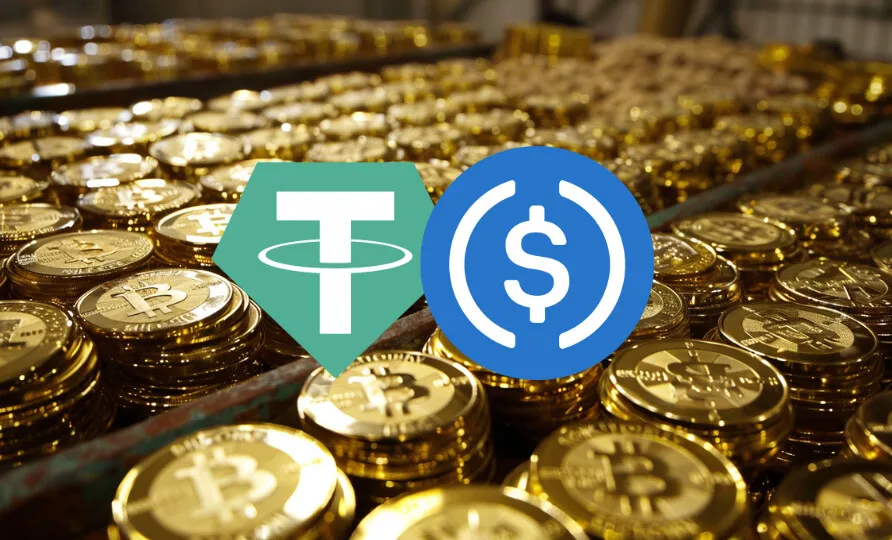The supply of stablecoins has grown slowly, but managed to recover to levels not seen since 2022. The influence of USDT and USDC may determine the strength of BTC and ETH in a market where liquidity is chasing more assets.
Stablecoins remain key for multiple derivative and spot markets. Recent statistics show the currently available stablecoins match the liquidity of 2022, and have the carrying potential to extend market growth. Usually, stablecoin inflows are following bullish attitudes, but stablecoin injections have been noticed even without an inflow of outside buyers.
In 2024, the distribution of stablecoin had a slightly different profile, after Binance moved away from BUSD and parked its funds into USDC, a dollar-backed and fully transparent stablecoin. Stablecoins also flowed into some of the most scalable blockchains, with record USDT volumes for Arbitrum and peak USDC usage on Base. The main apps that mop up the supply of stablecoins are decentralized exchanges like Uniswap or Trader Joe. Arbitrum is also the biggest recipient of Ethereum-based USDT.
Stablecoin market cap has reached levels that we haven’t seen since May 2022.
Bullish. pic.twitter.com/DPUI5rxNYT
— Peter Schroeder (@peterschroederr) July 18, 2024
The full picture of stablecoins and potential liquidity also includes several crypto-backed or algorithmic assets. DAI still has the biggest weight, with growth in USDe usage. Some stablecoins are also abandoned by European traders, after the introduction of new regulations in June.
Despite the limitations, the stablecoins supply rose by $15B in value in the past few weeks, for a total market capitalization of $165B. This includes a long tail of small stablecoins, with market cap under $10M. USDT grew its supply in the past week, rising from 112.6B to 114B tokens, coinciding with an overall market recovery.
Stablecoins also grew their turnover by a factor of 16 since the slump in 2020, and are able to support the current Bitcoin (BTC) price above $65,000, as well as some of the newly introduced tokens. Stablecoins have also flowed into liquidity pools and lending protocols, to ensure passive income without the need to trade.
Also Read: EU regulations shift the balance of Tether (USDT) and Circle USD (USDC)
The past few years also saw the emergence of a decentralized financial system, where stablecoins serve for arbitrage, collaterals, and liquidity pools. Stablecoins are a pitstop to lock in gains, but some users are skeptical about keeping them as a long-term storage.
Tether remains the leader in stablecoin issuance, with inflows to the Ethereum and TRON chains. Recently, Tether, Inc. also expanded its team with Philip Gradwell, former economist at Chainalysis. Tether aims to publish more transparent reports on the token’s usage in the real world.
Overall, stablecoin growth can be interpreted as a bullish factor, but it can also hide wider trends in crypto usage, including for illegal purposes.
Stablecoins seen as a tool for money-laundering
Deviating from their $1 stability price is the biggest risk for stablecoins, even ones backed by the US dollar. In the past, even USDC has stalled and stopped withdrawals, making users careful about using stablecoins as their main storage.
Stablecoins are also used for laundering or to move funds between wallets and accounts. They are widely accepted as a payment tool for fintech tasks, and have flowed into peer-to-peer markets or online shops. Stablecoin usage in money-laundering has been accelerating in Southeast Asia, also using online casinos or other online services.
Stablecoins are also replacing previous banking fraud, and inviting more scrutiny from regions that were previously liberal about crypto assets. That activity is only partially hampered by the ability to freeze funds, which is only available for part of the existing stablecoins. TRON-based tokens are one of the most widely used assets, with on-chain data showing a preference for holders from Iran. TRON-based stablecoins are driving out other crypto assets, including Bitcoin (BTC) and Ethereum (ETH).
Also Read: Regulated to illegal: which items are within reach for crypto holders
Potentially criminal usage has also accelerated token freezes for USDT. Formerly, the token was seen as immune to wallet blacklisting. However, the rise in personal scams and shady financing has led to more wallet freezes in the past week.
Starting in 2026, banks may also have stricter rules on disclosing their exposure to stablecoins or crypto assets. The Basel Committee on Banking Supervision finalized its latest guidelines on exposure, and expects the standards to be implemented at the start of 2026.
Cryptopolitan reporting by Hristina Vasileva





